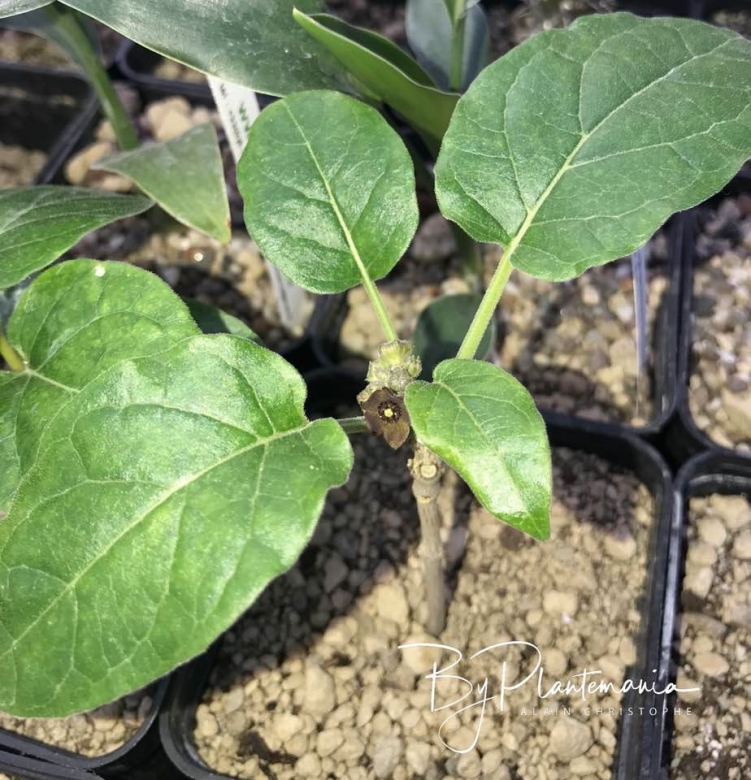




Your support is critical to our success.

Origin and Habitat: Cibirhiza dhofarensisSN|34777]]SN|34777]] is endemic to the Dhofar province, Sultanate of Oman on the Arabian peninsula, and is recorded now also from the neighbouring Al-Mahra, Yemen.
Habitat and ecology: This species grows in the wettest parts if coastal plains and slopes at medium altitudes of c. 400 m and amoung boulder in the upper zone of the evergreen woodland on the escarpment mountains (c. 850-900 m ASL), species such as Olea europaea subsp.cuspidata, Euclea schimperi, Sideroxylon mascatense, Sageretia thea, Rhus somalensis, but also Pistacia falcata, are merged with it. It is also found on cliff tops in degraded woodland dominated by Commiphora spp.; Blepharispermum hirtum & Euphorbia jatrophoides. It is extremely drought tolerant and slow growing.
Synonyms:
- Cibirhiza dhofarensis Bruyns
Description: Cibirhiza dhofarensis, also known as Cibirhiza dhofarica, is a small succulent with shortly erect or long and trailing stems to about 1 metres or twining. The flowers appears in dense clusters in leaf axils. The flowers are green with purplish brown minute spots about half a centimeter in diameter and stay open for two or three days. The fruits are single, erect, reddish brown.
Stems: Decumbent or twining to 1.5 m long, 3-8 mm in diameter, bark uneven.
Rootstock: Tuber brown, woody, elongated, globose to turnip-shaped, usually less than 15 cm in diameter, but may exceed 30 cm at maturity, edible
Leaves: Green fading yellow, 1-7 cm petiolate, blade is ovate to oblong-ovate, basally obtuse to cordate, apically more or less obtuse, 4-15 cm long, 1.5-10 cm broad, more or less pubescent. The few leaves the plant produces at the end of the stem, drop off before the flowers appear.
Inflorescences: The flowers are produced in a dense 15- to 25-flowered umbelliform clusters on the new growth at the end of the stem, but in older plants with more growth, they grow in the leaf axils. Pedicels 2-3 mm, pubescent .
Flowers: Rotate 10-14 mm in diameter. Sepals linear-subulate, about 2.5 mm long, hairy. Corolla pale green with red-brown spots and dots on the inner surface, outside pubescent, inside papillose. Corolla lobes triangular-ovate, about 4.5 mm long, 4 mm broad. Corona reddish brown to purple, ca. 3 mm across.
Fruits. Single, erect, mostly 7 cm long and 1 cm in diameter, fusiform, acute, smooth, glabrous, reddish brown.
Notes: Cibirhizas are closely related to Fockea, a well-known species of that genus being Fockea edulisSN|11329]]SN|11329]]. But the flowers are much less specialized than those of Fockea, superficially resembling those of a Stapelia, but smaller.
Bibliography: Major references and further lectures
1) Cibirhiza dhofarensis in: Paul Shirley Succulents - weblog for succulent friends, web: https://paulshirleysucculents.wordpress.com/2012/12/15/cibirhiza-dhofarensis/
2) JSTOR Global Plants, Isotype of Cibirhiza dhofarensis Bruyns web http://plants.jstor.org/stable/10.5555/al.ap.specimen.k000873061
3) P. Bruyns, "Studies in the flora of arabia XXI: Cibirhiza, a new genus of Asclepiadaceae from Oman", Notes from the Royal Botanic Garden, Edinburgh, Volume 45, H.M. Stationery Office, 1989
4) Anthony G. Miller, Miranda Morris, Susanna Stuart-Smith, "Plants of Dhofar: The Southern Region of Oman: Traditional, Economic and Medicinal Uses", Office of the Advisor for Conservation of the Environment, Diwan of Royal Court, 1988
5) Focke Albers, Ulrich Meve, "Illustrated Handbook of Succulent Plants: Asclepiadaceae", Springer Science & Business Media, 06 December 2012
6) Steve Jankalski, "FOCKEA, CIBIRHIZA AND PETOPENTIA", June 1998 issue of The Baltimore Areole, newsletter of the Cactus & Succulent Society of Maryland.
7) Kilian & al.: "New and noteworthy records for the flora of Yemen", Willdenowia 32: 249 2002
Cultivation and Propagation: Cibirhiza dhofarensisSN|34777]]SN|34777]] is an ideal plant for a small collection as it grows very slowly. Not suprisingly, it does appreciate warm temperatures, at least 20°C. Despite the fact that it grows in the full sun in the wild, it can be grown in the shade without any problem. Cibirhiza dhofarensisSN|34777]]SN|34777]] is used locally as a food plant. The tuber is supposed to be edible.
| Your Actions | |
|---|---|
| Back to Cibirhiza index | |
| Back to Asclepiadaceae index | |
 |
Back to Succulents Encyclopedia index |
Privacy stantement - Terms and conditions - How to cite - About us - Feedback - Donate




